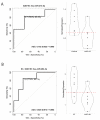miRNAs and isomiRs: Serum-Based Biomarkers for the Development of Intellectual Disability and Autism Spectrum Disorder in Tuberous Sclerosis Complex
- PMID: 36009385
- PMCID: PMC9405248
- DOI: 10.3390/biomedicines10081838
miRNAs and isomiRs: Serum-Based Biomarkers for the Development of Intellectual Disability and Autism Spectrum Disorder in Tuberous Sclerosis Complex
Abstract
Tuberous sclerosis complex (TSC) is a rare multi-system genetic disorder characterized by a high incidence of epilepsy and neuropsychiatric manifestations known as tuberous-sclerosis-associated neuropsychiatric disorders (TANDs), including autism spectrum disorder (ASD) and intellectual disability (ID). MicroRNAs (miRNAs) are small regulatory non-coding RNAs that regulate the expression of more than 60% of all protein-coding genes in humans and have been reported to be dysregulated in several diseases, including TSC. In the current study, RNA sequencing analysis was performed to define the miRNA and isoform (isomiR) expression patterns in serum. A Receiver Operating Characteristic (ROC) curve analysis was used to identify circulating molecular biomarkers, miRNAs, and isomiRs, able to discriminate the development of neuropsychiatric comorbidity, either ASD, ID, or ASD + ID, in patients with TSC. Part of our bioinformatics predictions was verified with RT-qPCR performed on RNA isolated from patients' serum. Our results support the notion that circulating miRNAs and isomiRs have the potential to aid standard clinical testing in the early risk assessment of ASD and ID development in TSC patients.
Keywords: autism spectrum disorder; biomarkers; epilepsy; intellectual disability; serum; tuberous sclerosis complex.
Conflict of interest statement
The authors declare no conflict of interest.
Figures




Similar articles
-
The TAND checklist: a useful screening tool in children with tuberous sclerosis and neurofibromatosis type 1.Orphanet J Rare Dis. 2020 Sep 7;15(1):237. doi: 10.1186/s13023-020-01488-4. Orphanet J Rare Dis. 2020. PMID: 32894194 Free PMC article.
-
Neuropsychiatric profile in tuberous sclerosis complex patients with epilepsy.Front Pediatr. 2025 Jan 15;12:1436061. doi: 10.3389/fped.2024.1436061. eCollection 2024. Front Pediatr. 2025. PMID: 39882213 Free PMC article.
-
The autism spectrum disorder phenotype in children with tuberous sclerosis complex: A systematic review and meta-analysis.Dev Med Child Neurol. 2022 Oct;64(10):1214-1229. doi: 10.1111/dmcn.15307. Epub 2022 Jun 20. Dev Med Child Neurol. 2022. PMID: 35724267
-
Tuberous Sclerosis Complex Patients' Needs and Difficulties-Results of TAND Questionnaire Analysis in Polish Adult Population.J Clin Med. 2022 Nov 3;11(21):6536. doi: 10.3390/jcm11216536. J Clin Med. 2022. PMID: 36362764 Free PMC article.
-
Autism and Epilepsy in Patients With Tuberous Sclerosis Complex.Front Neurol. 2020 Aug 11;11:639. doi: 10.3389/fneur.2020.00639. eCollection 2020. Front Neurol. 2020. PMID: 32849171 Free PMC article.
Cited by
-
mTOR pathway diseases: challenges and opportunities from bench to bedside and the mTOR node.Orphanet J Rare Dis. 2025 May 27;20(1):256. doi: 10.1186/s13023-025-03740-1. Orphanet J Rare Dis. 2025. PMID: 40426219 Free PMC article. Review.
-
Mechanistic strategies for secondary prevention of developmental and epileptic encephalopathy in children with tuberous sclerosis complex.EBioMedicine. 2025 Jun;116:105740. doi: 10.1016/j.ebiom.2025.105740. Epub 2025 May 13. EBioMedicine. 2025. PMID: 40367637 Free PMC article. Review.
-
Is tuberous sclerosis complex-associated autism a preventable and treatable disorder?World J Pediatr. 2024 Jan;20(1):40-53. doi: 10.1007/s12519-023-00762-2. Epub 2023 Oct 25. World J Pediatr. 2024. PMID: 37878130 Review.
-
Epileptogenesis in tuberous sclerosis complex-related developmental and epileptic encephalopathy.Brain. 2023 Jul 3;146(7):2694-2710. doi: 10.1093/brain/awad048. Brain. 2023. PMID: 36806388 Free PMC article. Review.
-
Circulating biomarkers of kidney angiomyolipoma and cysts in tuberous sclerosis complex patients.iScience. 2024 Jun 13;27(7):110265. doi: 10.1016/j.isci.2024.110265. eCollection 2024 Jul 19. iScience. 2024. PMID: 39027368 Free PMC article.
References
-
- Northrup H., Aronow M.E., Bebin E.M., Bissler J., Darling T.N., de Vries P.J., Frost M.D., Fuchs Z., Gosnell E.S., Gupta N., et al. Updated International Tuberous Sclerosis Complex Diagnostic Criteria and Surveillance and Management Recommendations. Pediatr. Neurol. 2021;123:50–66. doi: 10.1016/j.pediatrneurol.2021.07.011. - DOI - PubMed
-
- Sancak O., Nellist M., Goedbloed M., Elfferich P., Wouters C., Maat-Kievit A., Zonnenberg B., Verhoef S., Halley D., van den Ouweland A. Mutational Analysis of the TSC1 and TSC2 Genes in a Diagnostic Setting: Genotype--Phenotype Correlations and Comparison of Diagnostic DNA Techniques in Tuberous Sclerosis Complex. Eur. J. Hum. Genet. EJHG. 2005;13:731–741. doi: 10.1038/sj.ejhg.5201402. - DOI - PubMed
-
- Capal J.K., Williams M.E., Pearson D.A., Kissinger R., Horn P.S., Murray D., Currans K., Kent B., Bebin M., Northrup H., et al. Profile of Autism Spectrum Disorder in Tuberous Sclerosis Complex: Results from a Longitudinal, Prospective, Multisite Study. Ann. Neurol. 2021;90:874–886. doi: 10.1002/ana.26249. - DOI - PMC - PubMed
Grants and funding
LinkOut - more resources
Full Text Sources

